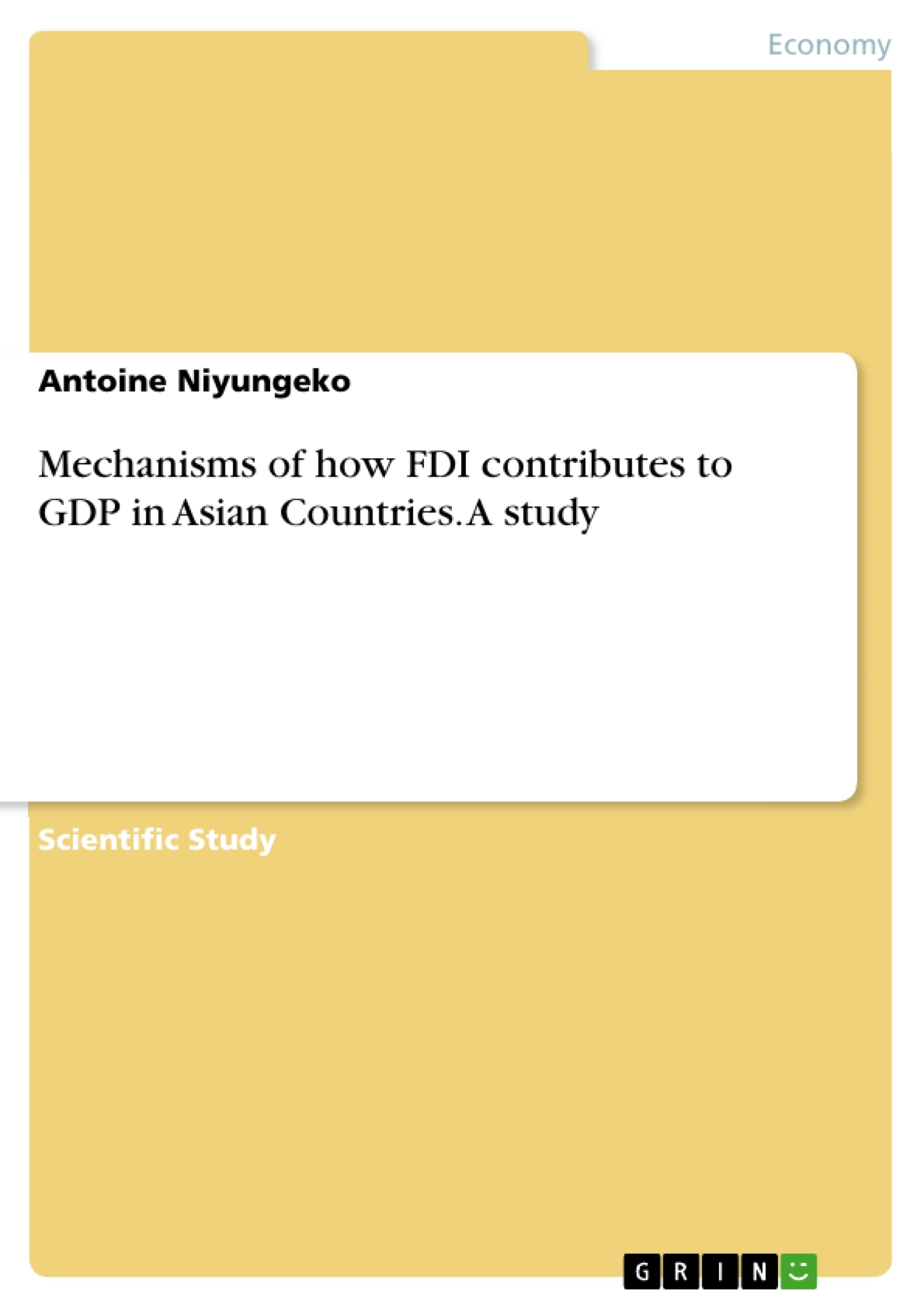The study aims to analyze mechanisms by which foreign direct investment inflows (FDI) contributes to gross domestic product (GDP) in Asian countries. FDI is used as an independent variable. GDP is used as dependent variable. Export (EXP), house hold consumption (HHC), and gross capital formation (GCF) are used as mediator variables. Many studies analyzed direct relationships between FDI and GDP without explaining how FDI contributed to GDP. Therefore, little is known about the way FDI contributes to GDP in the receiving country. The study focuses on the question: What is the indirect relationship between FDI and GDP in Asian Countries?
The novelty of this paper is to provide a deep understanding on how FDI is related to GDP in Asian countries which did not get much attention in prior literature. The study used causal mediation analysis with bootstrap procedure. Annual data 2018 related to FDI, GDP, EXP, HHC, and GCF were collected from the World Bank website.
The impact of foreign direct investment on economy growth got much attention in all continents. The findings of the prior researches show mixed results. Some of them concluded that FDI has positive impact on GDP. While other concluded that FDI has negative effect on GDP. For instance, Raghuveer and Muthusamy (2019) investigated the relationship between FDI and economic growth in some Asian countries including Bangladesh, China, India, Lao PDR, Mongolia, Korea Republic and Sri Lanka. They used Ordinary Least Squares, Augmented Dicky-Fuller and Granger Causality test, and found that the effect of FDI inflow on economic growth was not the same in the analyzed countries. Diouf and Hai (2017) examined the effect of the interaction between FDI, trade openness and economic growth with by focusing on Asian FDI, trade and 13 West African countries covering the period 1980-2015. They used Fully Modified Ordinary Least Squares.
Inhaltsverzeichnis (Table of Contents)
- Abstract
- 1 Introduction
- 2 Literature Review
- 3 Methodology
- 4 Result and Discussion
- 4.1 Descriptive statistics
- 4.2 Causal mediation Analysis
- 4.3 Managerial Implication
- 5 Conclusion
Zielsetzung und Themenschwerpunkte (Objectives and Key Themes)
This study aims to investigate the mechanisms through which foreign direct investment (FDI) contributes to gross domestic product (GDP) in Asian countries. It examines the indirect relationships between FDI and GDP, focusing on the role of mediating variables like exports, household consumption, and gross capital formation. The study explores how FDI can boost economic growth in Asian countries by analyzing its influence on these mediating factors.
- The relationship between FDI and GDP in Asian countries
- The mediating role of exports, household consumption, and gross capital formation in the FDI-GDP relationship
- The impact of FDI on economic growth in Asian countries
- The significance of FDI as a driver of economic development in Asian economies
- Policy implications for attracting and maximizing the benefits of FDI in Asia
Zusammenfassung der Kapitel (Chapter Summaries)
- Abstract: This chapter presents the study's objectives, research questions, and key findings. It highlights the gap in existing research on the indirect relationship between FDI and GDP, emphasizing the mediating role of exports, household consumption, and gross capital formation.
- Introduction: This chapter discusses the significance of FDI in economic growth and reviews previous research on the relationship between FDI and GDP. It highlights the mixed findings of prior studies, with some indicating a positive impact and others a negative impact of FDI on GDP. The chapter emphasizes the importance of understanding the indirect effects of FDI on economic growth.
- Literature Review: This chapter presents a comprehensive review of prior research on the impact of FDI on GDP, household consumption, and gross capital formation. It examines the various mechanisms through which FDI can contribute to economic growth and analyzes the diverse perspectives on the potential benefits and drawbacks of FDI in different economic contexts.
- Methodology: This chapter describes the research methodology used in the study, including the data sources, variables, and analytical techniques employed. It details the causal mediation analysis with bootstrap procedures used to examine the indirect relationship between FDI and GDP.
- Result and Discussion: This chapter presents the empirical findings of the study, including descriptive statistics and the results of the causal mediation analysis. It discusses the mediation effects of exports, household consumption, and gross capital formation on the relationship between FDI and GDP. The chapter also analyzes the implications of these findings for policymakers and business leaders.
Schlüsselwörter (Keywords)
This study focuses on the relationship between foreign direct investment (FDI) and gross domestic product (GDP) in Asian countries. Key themes include FDI's impact on economic growth, the mediating role of exports, household consumption, and gross capital formation, and policy implications for promoting FDI in Asia. The study utilizes causal mediation analysis to explore the indirect effects of FDI on GDP and provides insights into the mechanisms through which FDI contributes to economic development in Asian economies.
- Quote paper
- Dr. Antoine Niyungeko (Author), 2021, Mechanisms of how FDI contributes to GDP in Asian Countries. A study, Munich, GRIN Verlag, https://www.grin.com/document/991803




